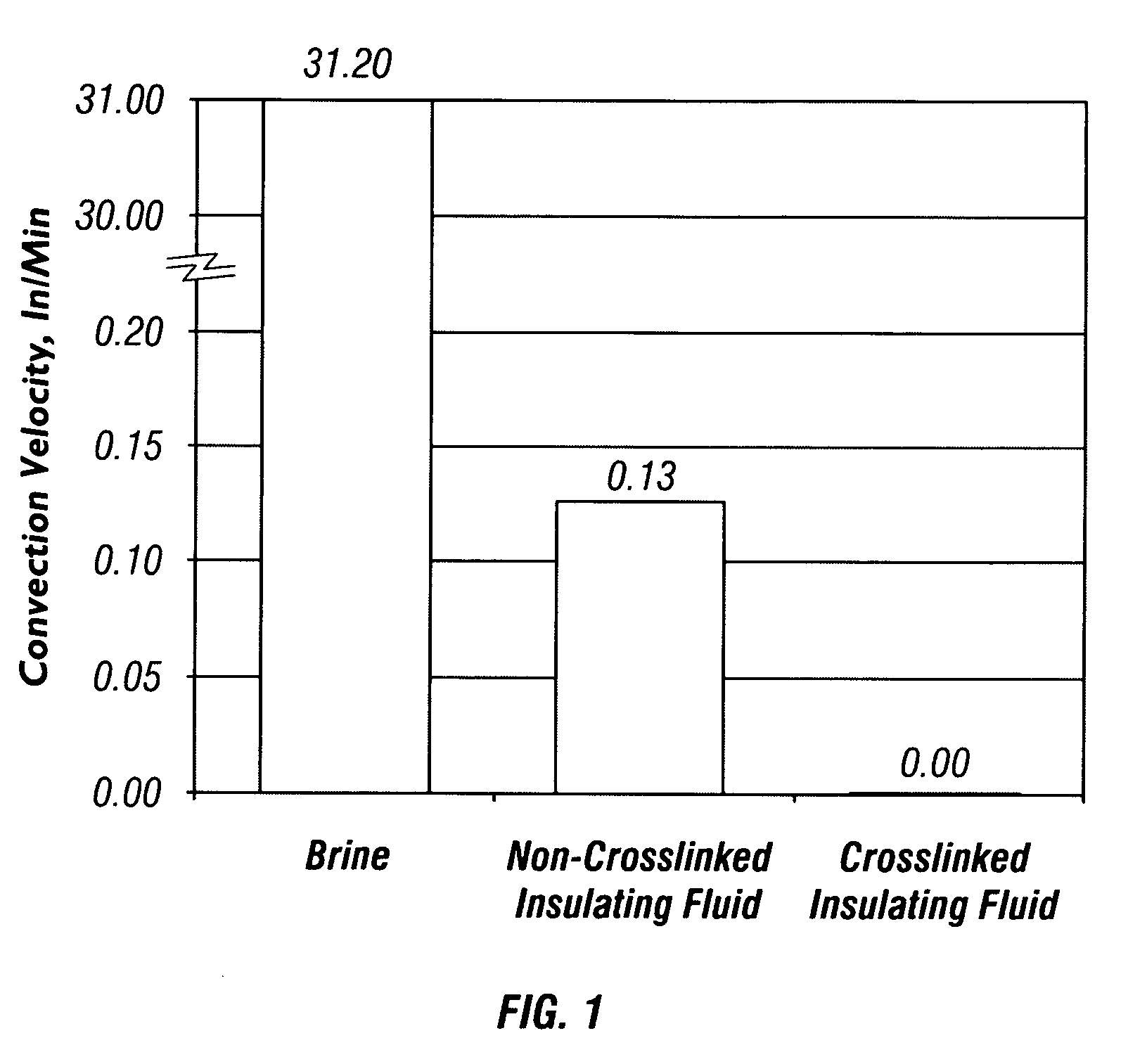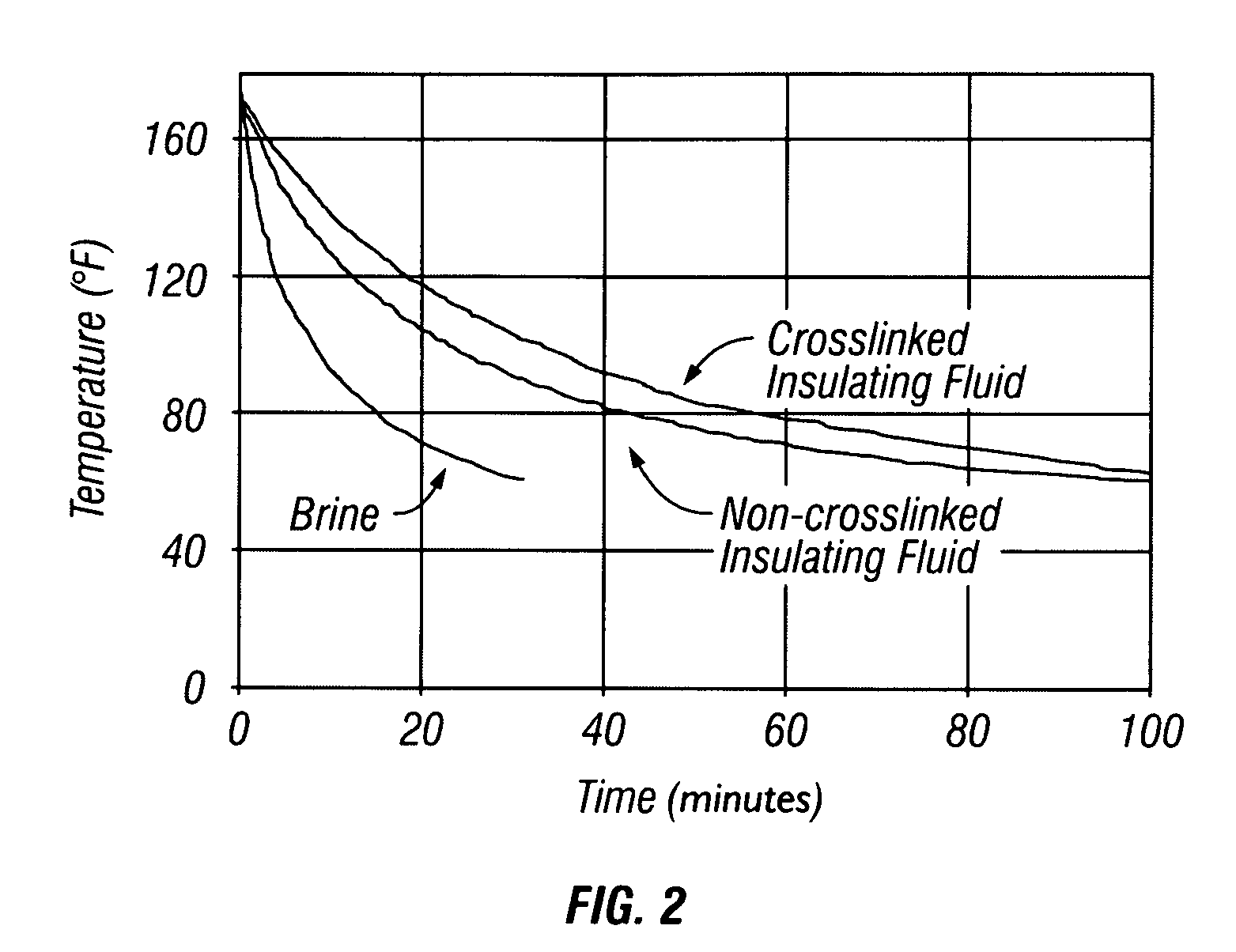Methods of using crosslinkable compositions
a crosslinkable composition and composition technology, applied in the direction of sealing/packing, borehole/well accessories, insulation, etc., can solve the problems of destabilizing the permafrost in arctic type regions, accelerating the formation of gas hydrates, and productivity loss, so as to achieve low viscosity, high viscosity, and easy pumping
- Summary
- Abstract
- Description
- Claims
- Application Information
AI Technical Summary
Benefits of technology
Problems solved by technology
Method used
Image
Examples
example 1
Example 1 Examines the Rheology of a Crosslinked Insulating Fluid
[0047]3 g of carboxymethyl hydroxypropyl guar (CMHPG) was added to 350 milliliters of sodium bromide brine which consists of water, propylene glycol (25 volume %), and sodium bromide salt (density=1.08 g / ml, or 9 pound / gallon) under rapid agitation.
[0048]After hydrating the mixture by a mechanical stirrer for 30 minutes, the pH was adjusted to about 9.5 with sodium hydroxide. Zirconium lactate crosslinker was added in an amount of 0.3 weight % based on the total weight of the aqueous solvent and the solution was mixed until it was fully crosslinked.
[0049]Thereafter, a 40 milliliter sample of crosslinked gel was placed into a Fann 50C viscometer cup. The cup was then placed on a Fann 50C viscometer and pressured to about 200 psi (14 kg / cm2) with nitrogen. The sample was sheared at 450 sec−1 for 2 minutes, followed by a rate sweep using 105, 85, 64, and 42 sec−1 for about 2 minutes. The oil bath temperature was pre-set t...
example 2
This Example Illustrates Crosslinking Delay Time with No Retarder Present and Thermal Stability at 180° F.
[0051]3 g of carboxymethyl hydroxypropyl guar (CMHPG) was added to 350 milliliters of sodium bromide brine which consists of water, propylene glycol (25 volume %), and sodium bromide salt (density=1.08 g / ml, or 9 pound / gallon) under rapid agitation.
[0052]After hydrating the mixture by a mechanical stirrer for 30 minutes, the pH was adjusted to about 9.5 with sodium hydroxide. Zirconium lactate crosslinker was added in an amount of 0.3 weight % based on the total weight of the aqueous solvent. The crosslinking delay time was monitored from the time of adding crosslinker to the time when vortex is closed.
[0053]Thereafter, the crosslinked gel was placed in a static oven at 180° F. The status of the gel was checked after 60 days and 150 days and the results set forth in Table 2.
[0054]
TABLE 2CrosslinkingRetardertime.60 days150 daysNoInstantGGG: gel,T: thin,B: broken
Example 3
This Exam...
example 4
This Example Illustrates Crosslinking Delay Time with Mannitol as Retarder Present and Thermal Stability at 180° F.
PUM
| Property | Measurement | Unit |
|---|---|---|
| Mn | aaaaa | aaaaa |
| pressure crystallization temperatures | aaaaa | aaaaa |
| density | aaaaa | aaaaa |
Abstract
Description
Claims
Application Information
 Login to View More
Login to View More - R&D
- Intellectual Property
- Life Sciences
- Materials
- Tech Scout
- Unparalleled Data Quality
- Higher Quality Content
- 60% Fewer Hallucinations
Browse by: Latest US Patents, China's latest patents, Technical Efficacy Thesaurus, Application Domain, Technology Topic, Popular Technical Reports.
© 2025 PatSnap. All rights reserved.Legal|Privacy policy|Modern Slavery Act Transparency Statement|Sitemap|About US| Contact US: help@patsnap.com


